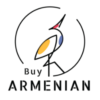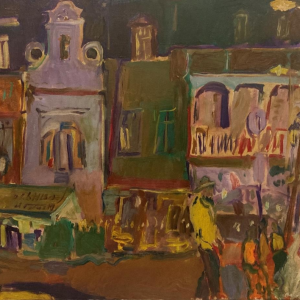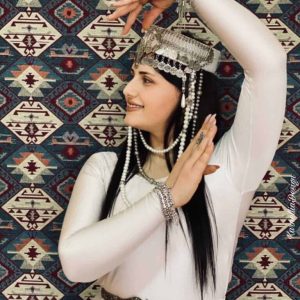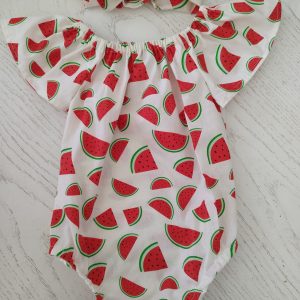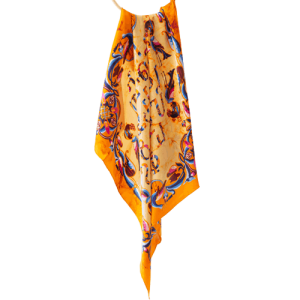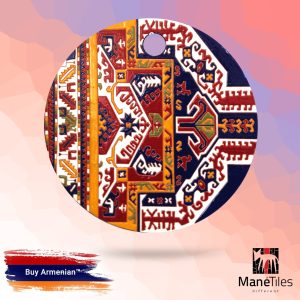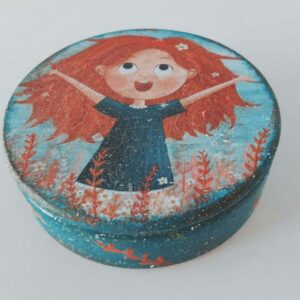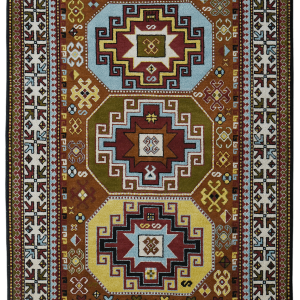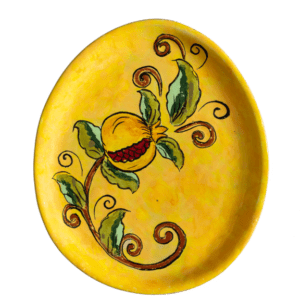-
Aybuben Backpack
• Made from 100% polyester
• Dimensions: H 16⅞” (42cm), W 12¼” (31cm), D 3⅞” (10cm)
• Maximum weight limit: 44lbs (20kg)
• Water-resistant material
• Large inside pocket with a separate compartment for a 15” laptop, front pocket with a zipper, and a hidden pocket with zipper on the back of the bag
• Top zipper has 2 sliders with zipper pullers
• Silky lining, piped inside hems, and a soft mesh back
• Padded ergonomic bag straps from polyester with plastic strap regulators$75.00Aybuben Backpack
$75.00 -
“Haiuhi” Armenian Headdress
Please Check Before Ordering
✨ Made to Order – Please allow up to 2 weeks for preparation before shipping.
$170.00“Haiuhi” Armenian Headdress
$170.00 -
Hand-Carved Large Wooden Jewelry Box with Grape Design
Handmade Large Wooden Grape Jewelry Box
$56.00 – $86.00Hand-Carved Large Wooden Jewelry Box with Grape Design
$56.00 – $86.00 -
Watermelon Summer Bodysuit-Infant
The Watermelon baby suite is made of 100% cotton fabric. It is a good solution of daily wear and photo shoots.
$18.00 -
Nacre Silver Earrings
Earrings made of 925 sterling silver
Natural wite nacre (mother of pearl)
Weight- 9,25 gr
Length- 3 cmEvery single detail is handmade
Processing time- 1-10 business days$115.00Nacre Silver Earrings
$115.00 -
“Armenian Alphabet” Scarf
The Armenian alphabet was created in 405 AD.
One of the greatest marks of the Armenian identity is the Armenian language. The exact origins of the Armenian language, however, are a little bit obscure. Such is the case with many ancient languages. Serious scholarship starting from the 19th century has placed Armenian among the wider family of Indo-European languages, although it forms its own separate branch within that group. So the language does not have any close relatives today, even Indo-European ones, such as Spanish and Portuguese or Russian and Polish might be considered.Armenian is also unique in its writing system. The Armenians use their own alphabet which was, by tradition, created following the studies and meditations of a monk, Mesrop Mashtots, in the early 5th century AD. Christianity had already been accepted as the national religion for a hundred years in Armenia, but the Bible was not yet available in the native language. The tradition goes that the main motivation to come up with a separate Armenian alphabet was in order to translate the Bible in such a way that would be accessible and suitable for the language and the people.
Mesrop Mashtots – who has since been venerated as a saint, as the patron of teaching and learning for Armenians – accomplished the task in the year 405 AD, thus setting the stage for a rich trove of works of religion and history, science and philosophy, illuminated manuscripts, and published books in the millennium and a half that followed, continuing on today. A major road in the capital of Armenia, Yerevan, is named for Mashtots, and one end of it is the apt location for the Matenadaran, the national repository of manuscripts which also functions as a research institute and museum.
$110.00 -
ARMENIAN DECORATIVE CERAMIC CHEESEBOARD
Decorative ceramic tableware is entirely handmade, made of clay and illustrated glaze.
$110.00 -
-
“Annunciation”
Size – 22/20 cm
Material – Red argil
Burned – 1100 Cº
Bas-relief
Frame size – 36/36 cm
Weight – 900 g
Shipping weight – 2 kg$66.00“Annunciation”
$66.00 -
Armenian Carpet – Mokhanq Arevagorg
Handmade carpet made in Artsakh․ This carpet belongs to the series of traditional Armenian carpets.
Technique: Handmade
Material: Wool
Node type: Double (Armenian)
Density: 32 x 32
Colors: Red
Made in: Artsakh (Armenia)
Weight (kg): 6.4
Size (sm): 192 x 120
Product code: KC0240185
This carpet has a certificate$2,150.00Armenian Carpet – Mokhanq Arevagorg
$2,150.00 -
Decorative Ceramic Plate
Decorative ceramic tableware is entirely handmade, made of clay and illustrated glaze.
$72.00Decorative Ceramic Plate
$72.00
